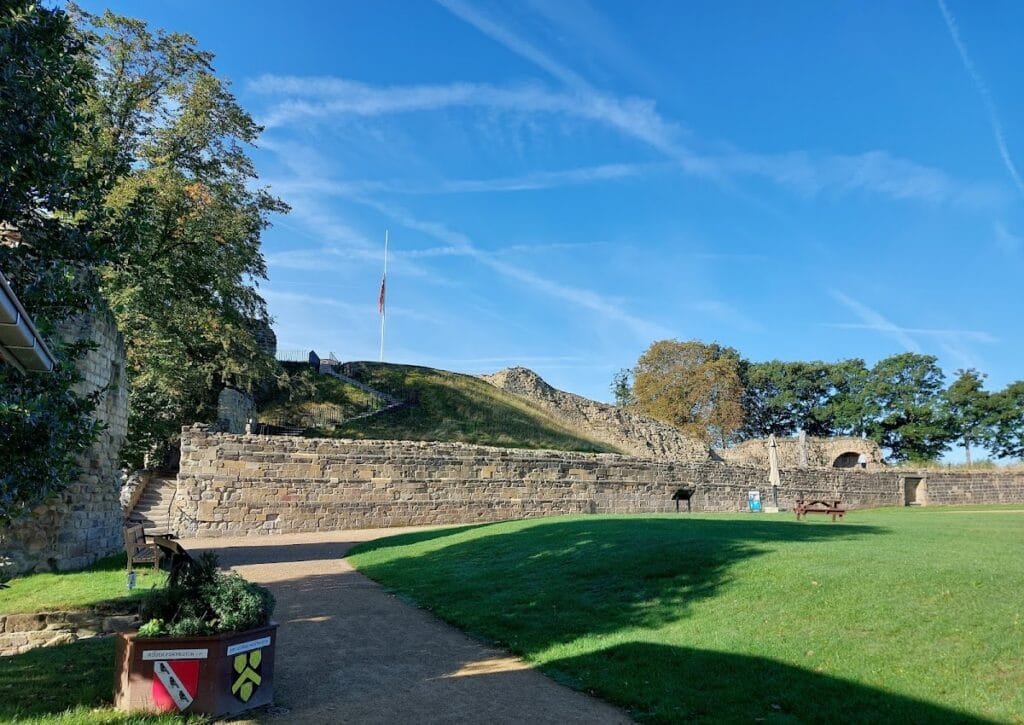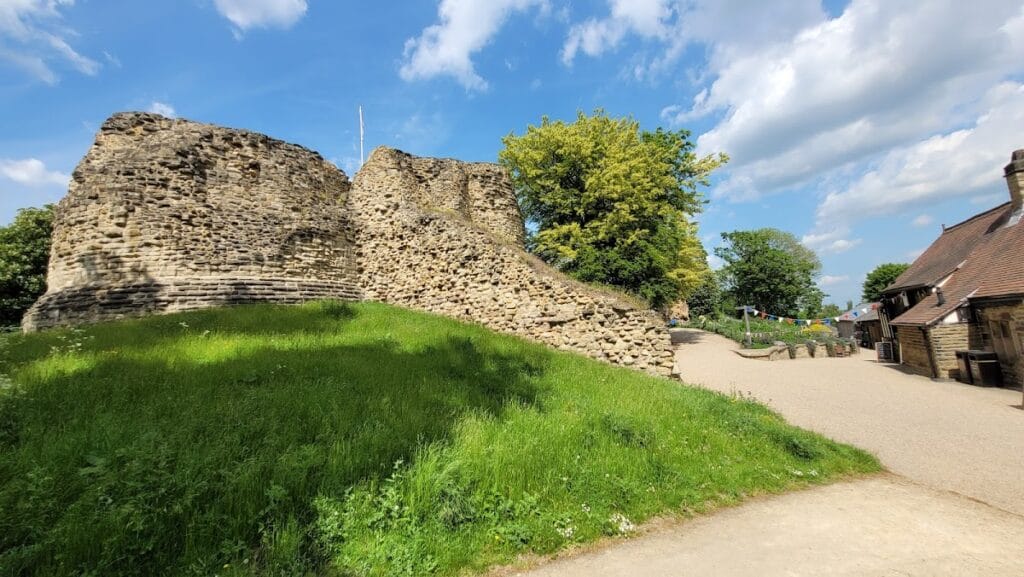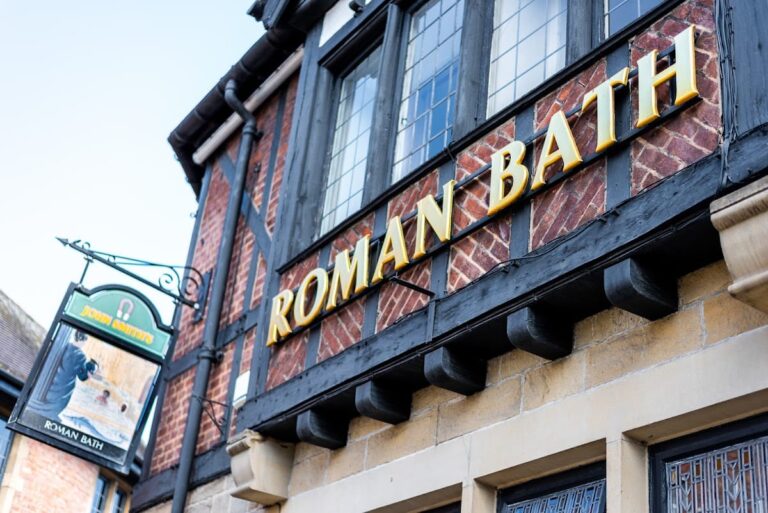Pontefract Castle: A Norman and Medieval Fortress in England
Visitor Information
Google Rating: 4.5
Popularity: Medium
Google Maps: View on Google Maps
Official Website: www.wakefield.gov.uk
Country: United Kingdom
Civilization: Medieval European
Remains: Military
History
Pontefract Castle, located in the town of Pontefract in England, was established by the Normans shortly after their conquest of 1066. The initial fortress was constructed around 1070 by Ilbert de Lacy, who received the land from William the Conqueror as a reward for his role in the Norman invasion. Originally built in wood, the castle was later rebuilt in stone, growing in strength and importance throughout the medieval period. Early records from the Domesday Book in 1086 likely mention the site under the designation “Ilbert’s Castle,” linking it directly to its founder.
During the 12th century, the castle’s ownership shifted due to political upheavals. King Henry I confiscated it from Robert de Lacy, a descendant of Ilbert, only for the de Lacy family to regain possession under King John in 1199. The de Lacys maintained residence there into the early 1300s. This era saw important architectural developments, including the construction of a distinctive multilobed stone keep, known as a donjon, reflecting advances in castle design.
The early 14th century brought significant political change when the castle passed by marriage into the House of Lancaster in 1311. Thomas, Earl of Lancaster and a powerful noble, was executed outside the castle walls in 1322 following his defeat at the Battle of Boroughbridge. Thomas gained a reputation as a martyr, and his tomb at nearby Pontefract Priory became a site of veneration.
In the late 14th century, John of Gaunt, son of King Edward III, made Pontefract Castle his private residence, investing in considerable improvements. Later, in 1399, King Richard II was imprisoned within its walls after being overthrown by Henry Bolingbroke, who became King Henry IV. Richard II died in the castle, possibly in early 1400, under circumstances that remain unclear.
The turbulent Wars of the Roses era brought further violence to the site. In 1483, King Richard III ordered the execution of Sir Richard Grey and Anthony Woodville, relatives of Elizabeth Woodville, within the castle grounds after seizing power. During the Tudor period, the castle played a role in the 1536 Pilgrimage of Grace, a major Catholic uprising. Thomas Darcy surrendered Pontefract Castle to the rebels, a decision that led to his execution for treason. King Henry VIII visited in 1541, with later accounts associating the castle with alleged adultery by his fifth wife, Catherine Howard.
Mary, Queen of Scots, was held at Pontefract Castle briefly in January 1569 during her movements through England. The castle’s final significant military role came during the English Civil War in the mid-17th century, when it served as a Royalist stronghold. Between 1644 and 1649, the castle endured three arduous sieges by Parliamentary forces. Severe damage was inflicted by artillery fire and undermining mining tactics, causing the collapse of key structures including the Piper Tower. After the last siege led by Oliver Cromwell, the garrison surrendered in March 1649, and Parliament issued orders for the castle’s demolition to prevent further military use.
Archaeological investigations carried out in recent years uncovered Civil War-era lead shot and builder’s marks in the drawbridge pit, highlighting the site’s prolonged military significance. The original 11th-century underground cellars, which were later used for storing military supplies during the sieges, have survived and remain accessible.
Remains
Pontefract Castle is positioned atop a rocky outcrop just east of the town, overlooking the nearby All Saints’ Church. It features an inner and an outer bailey, or courtyard, enclosed by stone walls that have withstood centuries of conflict and decay. The surviving curtain walls have been carefully excavated and smoothed, revealing traces of 12th-century masonry alongside fragments of the castle’s extended defenses.
Among the extant gateways, the Great Gate stands out, flanked by two semi-circular towers dating from the 14th century. This entrance complex includes both inner and outer barbicans—fortified outworks designed to strengthen the castle’s defenses. To the north, remains of a rectangular tower mark the site of the North Bailey gate, guarding one of the castle’s main access points.
A prominent medieval chapel once stood within the grounds, with its foundations still visible today. Carved chambers within the rock of the inner bailey are likely the remains of the castle’s great hall, where lords would have held court and managed their affairs. These rock-cut spaces underline the adaptation of the natural landscape to castle architecture.
One of Pontefract’s most unusual features is its multilobate donjon, a tower with a rare quatrefoil shape composed of four rounded lobes. This form is seen only in a few other medieval castles, including Clifford’s Tower in York and the Château d’Étampes in France, indicating a significant architectural innovation during the early 14th century.
Another distinctive element is the Swillington Tower, classified as a torre albarrana. This detached tower is connected to the castle’s north wall by a narrow bridge, enabling defenders to extend their range of flanking fire and better protect the curtain walls. Such a design is rare in England and more commonly found in Iberian fortifications.
Among the ruined towers, the Piper Tower was a casualty of the Civil War sieges; mining and sustained artillery fire led to its collapse during the mid-1600s. Its remains serve as a stark reminder of the castle’s violent past.
Restoration work, begun in 2015 and completed by 2019 despite temporary delays, has stabilized many parts of the ruin and facilitated its removal from the national “Heritage At Risk” register. Excavations during this period uncovered numerous mason’s marks—symbols left by stonemasons—and Civil War lead bullets within the drawbridge pit, directly connecting the fabric of the castle to episodes of siege warfare.
The original 11th-century subterranean cellars beneath the castle have remained intact through the centuries. These vaulted chambers, once used for military supplies during the Civil War, are still open and offer a tangible link to the castle’s early Norman origins and multifunctional use across its history.










